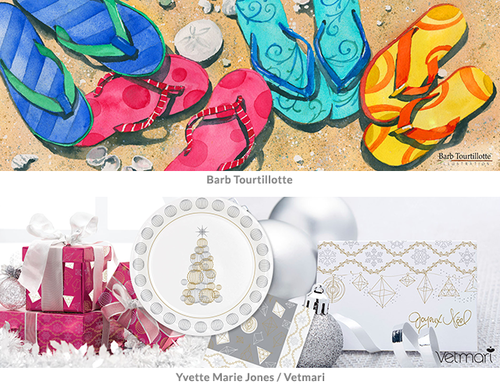by Carolyn Edlund
Art licensing is an option for artists, but it’s not right for everyone. How does it work, and how can artists become involved in this market?

Examples of licensed images from artists Barb Tourtillotte and Yvette Marie Jones. Photo courtesy ArtLicensingShow.com
Art is everywhere in our lives. Quite often the art you see printed on products was licensed by the manufacturer from an artist who makes their living designing for this market. Artists who want to pursue licensing need to learn as much about the industry as possible. They must determine if their work is a fit. And, they have to understand how business is done.
What exactly is licensing? It’s a contractual agreement between the artist (licensor) and the client (licensee). This agreement permits the licensee to use specified art images in the manufacture of specified products, for a set period in a set geographical area. For example, you may be licensing six images to be used on ceramic dinnerware, for a contract term of three years, for distribution and sale in North America. Licensing does not convey copyright, which is retained by the artist.
Artists may receive an advance at the time of signing a contract. Typically, however, they are paid through quarterly royalty payments. These are based on a percentage of sales of products that are manufactured using their images. These percentages will vary. It not unusual for an artist to receive between 3% – 7% of the wholesale price.
Is your work a fit?
If you wish to enter the licensing world, you should have a very good idea of the type of products that are appropriate for the art you create. Then you can design a portfolio which is prepared specifically for licensing with certain prospective customers (manufacturers) in mind.
Other artists license their work to art publishers, who print and distribute “wall décor” as posters, prints, framed art, etc. in the wholesale market. In recent years, many art publishers have also acted as agents for their artists. This has resulted from a market contraction, causing publishers to seek additional income streams. As agents, they help their artists procure contracts with other manufacturers.

The Surtex art licensing trade show takes place in New York City.
Once you have determined that licensing is an appropriate path for you, you will need to prepare a portfolio, and market your work. How is that done?
Create a website geared for licensing.
If your primary business focus is art licensing, your website should reflect this. Present collections of art that work together, prepared specifically with licensing in mind. Your website may contain mockups that feature your designs on particular products. In this way, they suggest uses that are appropriate for your work.
Gain representation by licensing agents.
If you are represented by an agency, they will search for clients for you. These agents are knowledgeable about the business. They also have a relevant network of business connections. And, agents can assist you in understanding trends and what customers are seeking. Typically, agents will take 50% of your royalties as their commission. It can be challenging to get agency representation, however. When researching agencies to approach, take a look at the artists they already represent. If your work is a good fit for their niche, you might want to contact them for consideration if they are open to receiving submissions.
Exhibit at trade shows.
Trade shows that cater to the licensing market are a meeting place for artists, agents, and clients searching for new images for their products. SURTEX, which takes place in New York City, is the largest and best-known U.S. trade show of this type. Trade shows can be expensive. A commitment to exhibiting over a period of years is suggested in order to get traction. As you are seen repeatedly by potential clients, they will come to know your work. Then, they may consider your art if it is a match for their product lines.
Participate in online licensing portals.
Websites such as Art Licensing Show and Art Licensing International function as “virtual trade shows”. They present the portfolios of artists to potential clients. These sites have password-protected areas that can be accessed by legitimate members of the trade. They are juried; artists may submit their work for consideration.
Solicit prospects and submit work directly.
Online research will turn up art publishers and manufacturers who are willing to accept submissions from artists for possible licensing contracts. If you wish to submit, put together the best presentation of your art. Then, follow instructions to the letter.
What to know when you have a licensing contract.
Once a licensing contract is in place, the artist must work closely with the manufacturer. Typically, artists provide images exactly as needed by the client, and deliver them digitally, ready for use in printing. Oftentimes deadlines are in place and timelines are tight. The artist must be flexible, reliable and willing to work with their client to meet those needs.
Keep in mind that as a licensed artist, you are producing art for the purpose of enhancing the saleability of your client’s products. After all, the reason that manufacturers choose to license art is to make their products more appealing in the marketplace, and to increase sales. If your images help products sell, you are in a win/win situation that should serve to bring you more business.
Artists who make a living in the licensing world often have numerous contracts with a variety of manufacturers. Repeat business in this market is key. Experienced licensed artists know this and work hard to develop strong relationships with their clients that last for years.
Art licensing covers other scenarios as well, including single-use licenses, the stock photo market, and even print-on-demand. The industry is diverse, offering a number of opportunities for artists.
As you become involved in the art licensing field, there are many details about contracts, trends, and business practices you will need to learn. Maria Brophy, Joan Beriger and J’net Smith all write helpful blogs that can assist you as you navigate the licensing world.


Thanks – this excellent article was just what I was looking for.
For the last couple of months, I’ve considered how to expand my art – abstract paintings – to other products.
The main question was: Should I license or control production and marketing of the products myself?
With the article I now have a good basis for making my descision.
BR Michael
https://artbylonfeldt.dk
Michael, your question is a good one, and of course there are two main differences: if you license, then you are turning over the image to a manufacturer, who will pay you royalties and it will become “passive income” after you deliver. Of course, you will be only a small part of the process, and earn a small part of the sales.
If you produce, market, and sell yourself, you are doing studio work, shipping, handling accounts and making sales. This will pay you a LOT more, but then, it’s a lot more involved. There is always a trade-off. Do you want to do the work yourself, and earn more, or hand it off and make much less? Do you have the time and inclination to be in a production studio business? Many artists are, and love it. Other artists would never consider production, but licensing works for them.